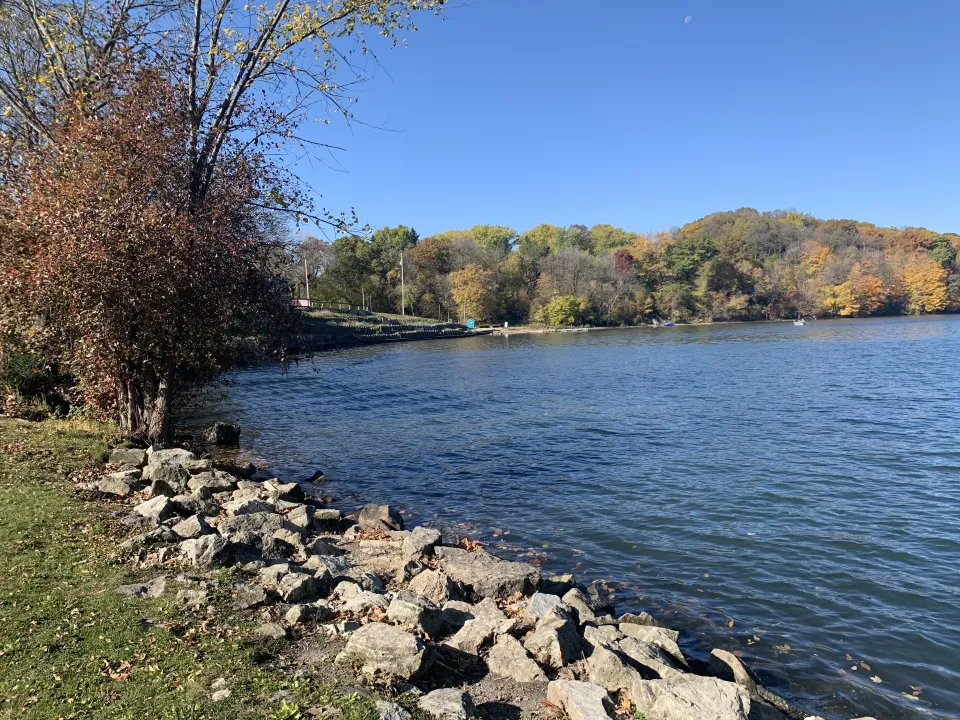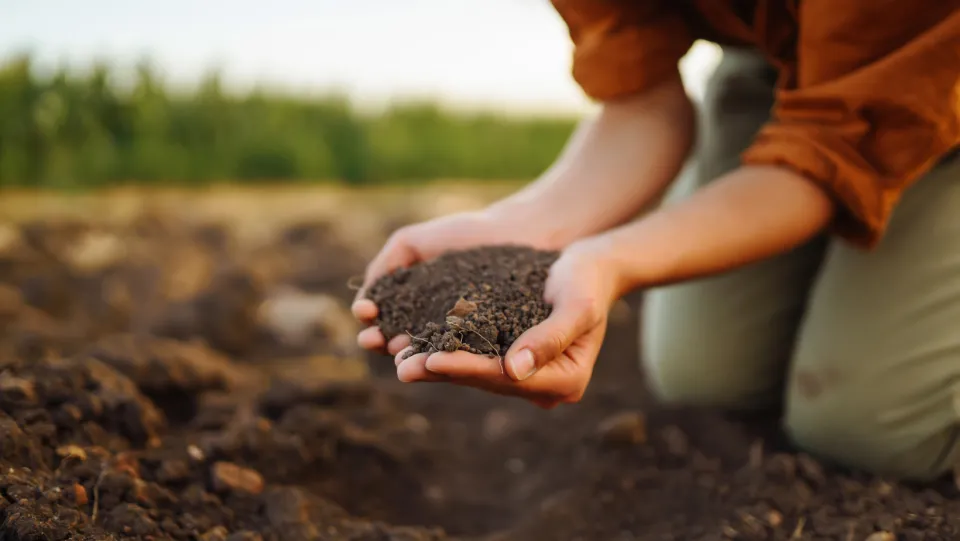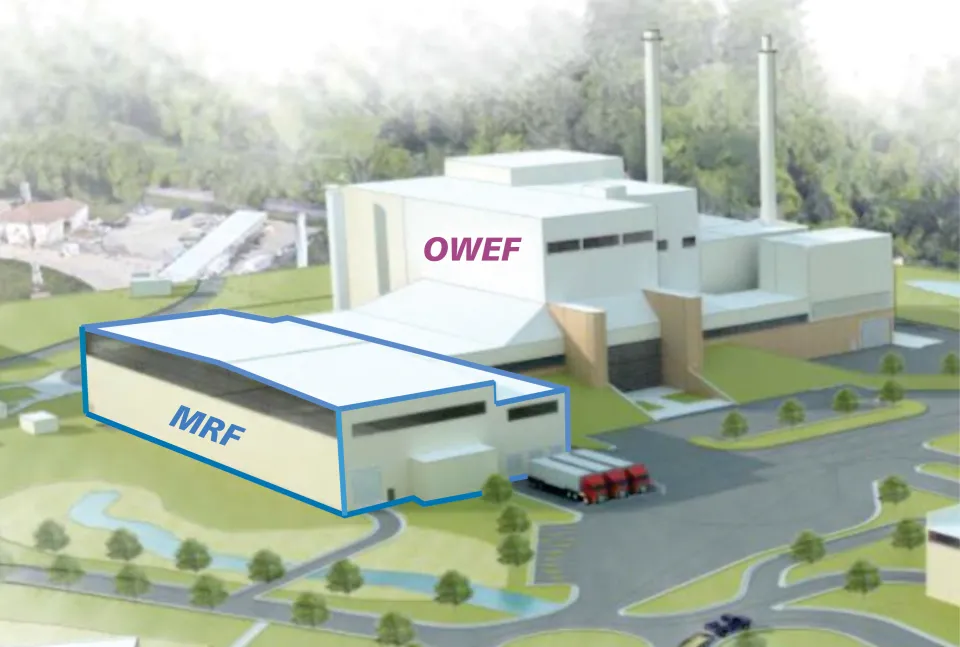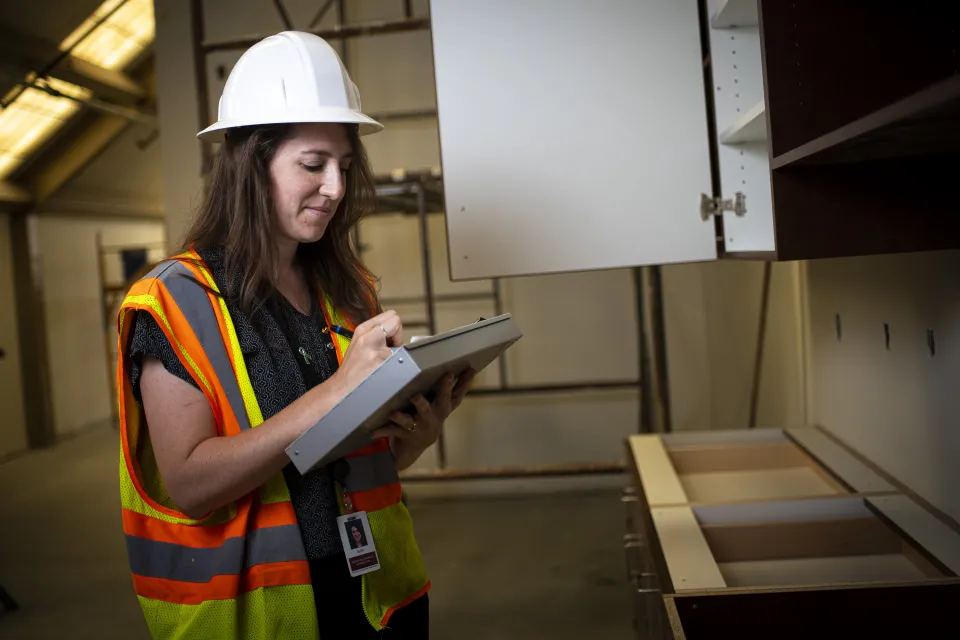Climate mitigation and adaptation

Goal: Build a more sustainable and climate-resilient community.
What climate change means for Olmsted County
Minnesota communities are experiencing increasing climate change impacts. Olmsted County needs to prepare for and equitably adapt to climate change impacts so that current and future generations can survive and flourish. Learn more about climate change impacts across Minnesota.
The climate action plan
Olmsted County is taking actions toward preventing climate change effects and responding to climate impacts already occurring. Olmsted County’s action plan includes 31 activities specific to our operations. The activities focus on climate mitigation and adaptation.
What is climate mitigation?
Climate mitigation means taking actions to slow down climate change by reducing the amount of greenhouse gases we release into the atmosphere. This includes things like using renewable energy (like solar and wind) instead of fossil fuels, and making our homes and buildings more energy efficient.
What is climate adaptation?
Climate adaptation means preparing for the changes that are already happening due to climate change. It helps us protect our homes, communities, and natural resources from things like flooding, heat waves, and other extreme weather events.
Water

What you can do
Implement water-efficient practices.
The Minnesota Department of Natural Resources has numerous tips on how residents can incorporate more water-efficient practices. Some examples include:
- Reducing outdoor watering on lawns and landscaping by adopting efficient landscaping and drought-resistant plants.
- Find and fix leaks within the home.
- Replacing older shower heads, taps, faucets, and toilets for more efficient options.
Apply for the Agricultural Best Management Practices (AgBMP) Loan Program
The AgBMP Loan Program is a water quality program that provides low-interest loans to Minnesota farmers, rural landowners, and agriculture supply businesses to encourage practices that prevent or reduce runoff from feedlots, farm fields, and other pollution problems identified in local water plans.
Volunteer with the Citizen Stream Monitoring Program (CSMP)
Join more than 1,400 Minnesotans who track the health of their favorite lake or stream by volunteering to become a citizen water monitor.
What the county is doing
Nature-based stormwater management – Olmsted County has implemented effective nature-based stormwater management techniques and plans to make them mandatory.
Reduce water usage for irrigation purposes – The irrigation at the Government Center will be disconnected to reduce water usage for irrigation purposes.
Establishing water refill stations at all drinking fountains and promoting reusable water bottles – Olmsted County is decreasing plastic consumption, waste, and pollution by replacing standard drinking fountains in county buildings with filter and water refill options.
Decreasing impermeable surfaces and installing rain gardens, rain barrels, and cisterns – Rain gardens and barrels reduce the risk of flooding, improve soil health, filter pollutants that contribute to water pollution, and improve water security.
Reduce salt use on county roadways – Olmsted County is implementing measures to reduce the amount of salt and sand on walking paths and roads, minimizing the amount that eventually ends up in waterways and the water table.
Soil

What you can do
Participate in the Olmsted County Soil Health Initiative
The Soil Health Initiative promotes the use of beneficial management practices and crop rotations to improve soil health and protect groundwater.
Apply for the State Cost Share Program
The Olmsted Soil and Water Conservation District has state funding available to share in the cost of practices for erosion control, sedimentation control and water quality improvements designed to protect and improve soil and water resources.
What the county is doing
Education and outreach on sustainable soil management – Olmsted County focuses on community education and outreach programming on best practices for soil management and regenerative agriculture on private lands to sequester carbon and reduce nutrient leaching to our waters.
Land use
What you can do
Volunteer with Olmsted County Parks
Olmsted County seeks volunteers for various jobs, including grounds and trail maintenance, programming and education, controlled burns, seed collection, and more. Apply online.
What the county is doing
Establish no-mow areas and natural prairies in the county’s underutilized building spaces - Olmsted County is creating no-mow areas and natural prairies to reduce gasoline and mower use. This initiative will introduce native vegetation into urban areas and seed native pollinator pockets in traditional turfgrass landscapes.
Prioritize native planting on landfill soil grounds – Olmsted County will reduce the need for mowing, emissions, irrigation, and erosion control by planting native species, improving biodiversity in a traditionally inhospitable location.
Plants
What you can do
Participate in the Olmsted Soil and Water Conservation District (SWCD) tree sale
Olmsted County sells trees and shrubs in mid-October, with plants available for pick up in April. Olmsted County also sells seed mixes and plant kits in February or early March.
What the county is doing
Establish sustainable, native and pollinator-friendly plants in county parks – Olmsted County is planting more sustainable, native, pollinator-friendly plants in our parks for a healthy environment.
Plant more trees and vegetation on building sites – Adding trees and smaller vegetation into county building sites will increase shade around buildings, reduce carbon emissions, reduce water runoff, and provide erosion control.
Air
What you can do
Implement practices to keep the air cleaner
The air we breathe can sometimes be polluted and harmful to our health and nature. But we can all do our part to keep the air clean and protect ourselves. By following some simple steps, we can reduce air pollution. AirNow, a program run by the EPA, has valuable tips on how we can help keep the air clean. Some examples include:
- Using clean, efficient, and sustainable ways to get around.
- Using environmentally safe pains and cleaning products.
- Conserve electricity by setting your thermostat a little higher in the summer and lower in the winter.
What the county is doing
Install Minimum Efficiency Reporting Values (MERV) 13 (or higher rated) filters on new and replacement air handlers – The higher the MERV rating, the better an HVAC filter is at trapping specific particles. This decreases the amount of air pollution exposure, improves indoor air quality, and promotes a healthier work environment.
Waste management
What you can do
Reduce Food Waste
The United States Department of Agriculture estimates that 30-40% of our nation's food supply is wasted yearly. This amounts to billions of dollars in wasted food. Locally, Olmsted County's 2019 Waste Composition Study found that food waste comprised 21% of our trash by weight.
The U.S. Food & Drug Administration and Environment Protection Agency have some tips on reducing food waste:
- Preplan and write out your shopping list before going to the grocery store.
- Be careful when buying in bulk if the food has a limited shelf life.
- If available, purchase "ugly" fruits and vegetables—sometimes listed at a lower price.
- Keep a running list of meals and their ingredients that your household already enjoys.
- Look in your refrigerator and cupboards first to avoid buying food you already have.
- Many fruits give off natural gasses as they ripen, making other nearby produce spoil faster. Store bananas, apples, and tomatoes by themselves, and store fruits and vegetables in different bins.
- Use the FoodKeeper app for food and beverage storage tips.
Recycle
Recycling is an easy way to conserve resources, prevent pollution, and reduce waste. Unfortunately, people often throw the wrong items in their recycling cart. Olmsted County’s Curbside Recycling Cart Guide was created to teach residents (regardless of who their hauler is) what can and cannot go in their curbside cart.
Mulch your grass clippings and leaves
Save time and energy by mulching your grass clippings and leaves. You’ll be providing your lawn with a great source of nutrients and organic matter. You’ll also save money on gas by avoiding a trip to the Compost Site.
What the county is doing
The majority of Olmsted County overlies karst bedrock. This type of geology is primarily comprised of limestone containing numerous fissures, sinkholes, and caves. These natural conduits allow surface water/pollutants to easily flow into underlying aquifers. The abundance of karst significantly limits our ability to site a new landfill.
Olmsted County’s Integrated Solid Waste Management System
Olmsted County is committed to environmental protection, stewardship, and accountability. This is shown by its investment in its integrated solid waste management system (ISWMS) over the last 35 years.
The county’s ISWMS offers a comprehensive waste prevention, recycling, composting, and disposal program for the community. The holistic system uses various waste management methods (e.g., community education and outreach, waste and toxicity reduction, reuse, recycling, composting, resource recovery, and landfilling) depending on the characteristics of the waste and following Minnesota Waste Management Hierarchy. Services and facilities within the ISWMS include:
- Educational Outreach
- Hazardous Waste Facility
- Recycling Center Plus
- Yard Waste Compost Site
- Waste-to-Energy Facility
- Kalmar Landfill
Expand recycling program for county buildings – Expand the recycling program to include other recyclable materials, such as cardboard and glass, in all county buildings.
Develop internal waste diversion strategies and goals – Develop a countywide internal waste diversion strategy to improve the county's internal and operational waste management practices during demolition and building projects.
Educate on the waste-to-energy facility for employees and community members – Provide more knowledge and understanding to staff and community regarding garbage and where it is burned in Olmsted County.
Use ash in pavement mix – Use ash and crushed concrete from the Olmsted Waste to Energy Facility and the Kalmar Landfill to supplement road gravel.

Establish Materials Recovery Facility (MRF) – Obtain funding for a MRF to be operational by 2025. This will help improve the use of recyclable materials, advocate for better waste management practices, support the integrated waste management program, and ensure that new construction meets sustainable building guidelines.
Implement a countywide food waste composting initiative – An initiative to establish an environmentally conscious way of properly disposing of organics waste in the county facilities, including a composting site.
Recycle road materials (asphalt) – Maximize the life of resources and reduce material hauling, carbon footprint, and toxic materials into the ground.
Promote paperless practices – Reduces excessive printing practices by providing digital forms and publishing material online.
Eliminate unnecessary single-use plastic purchases for county businesses – Decrease single-use plastic throughout the organization, reducing plastic consumption, waste, and pollution.
Explore organic waste diversion through international collaboration – Olmsted County continues to partner with the University of Minnesota’s Climate-Smart Municipalities German Exchange Program to explore innovative approaches to sustainable waste management. Through the collaboration, the county has conducted research on the feasibility and benefits of implementing organic waste diversion within its solid waste system. These studies have helped identify environmental, economic, and logistical advantages of diverting food waste from landfills and waste-to-energy facilities while outlining strategies that support the county’s long-term sustainability goals.
Expanding organic waste management programs – Olmsted County is enhancing organic waste management through food scrap composting and food rescue initiatives. The Food Scrap Collection and Composting Program provides drop-off locations and education for residents and organizations, helping reduce landfill waste and increase community awareness. The county continues to expand access to multi-family residences and commercial properties while strengthening partnerships through the Food Rescue Program, which redirects surplus food to local organizations and promotes responsible management of inedible food through composting and other sustainable uses.
Energy use
What you can do
In the U.S., households use energy to power many devices and equipment at home. However, according to the U.S. Energy Information Administration, over half of a household's yearly energy consumption is used for only two things: heating the home and cooling it with air conditioning. Water heating, lighting, and refrigeration are also standard and require energy throughout the year. These three things use up about 27% of a home's yearly energy consumption.
The U.S. Department of Energy has many tips for residents to save energy and save money while also saving the planet:
- Homeowners can get up to $150 off a professional home energy audit to map out energy savings.
- Renters can find incentives and tips and tricks to cut energy costs.
- Drivers can learn how to qualify for electric vehicle incentives.
What the county is doing

Upgrading existing buildings with energy-efficient systems – Olmsted County is focused on making county buildings more efficient and greener by retrofitting buildings with LED lights, reviewing programmed temperature settings, finding more efficient heating and cooling systems, sealing air leaks, and high-performing building envelopes.
Monitoring and assessing energy usage at facilities – Olmsted County is performing energy audits, continuing to monitor energy usage on county properties, and implementing energy use goals like energy use intensity.
Sustainable and flexible workplace practices – Olmsted County is committed to creating a work environment that supports both people and the planet. Through a responsive facilities plan for remote and hybrid work, the county is promoting efficient use of space, reducing greenhouse gas emissions from transportation, and supporting better work-life balance. These efforts also drive improvements in workplace technology and enhance employee engagement and productivity. In addition, staff are encouraged to take part in everyday energy-saving practices, such as turning off lights and computer monitors when not in use, avoiding personal appliances, and reducing disposables at lunch, to further reduce the county’s environmental footprint.
Implementing electrification and renewable energy for county buildings – Existing Olmsted County buildings will have system upgrades to electrify and use renewable energy, including geothermal systems.
Use battery-powered tools (lawn mower, leaf blower, etc.) instead of gas – When it’s time to replace current tools, Olmsted County will consider using battery-powered tools instead of gas-powered ones.
Expanding renewable energy in county facilities – Olmsted County is advancing renewable energy use across its facilities through the installation of solar panels, geothermal systems, and other energy-efficient technologies. These investments are helping reduce reliance on fossil fuels, improve operational efficiency, and lower long-term costs. Ongoing projects continue to build on the county’s commitment to sustainability, supporting its Climate Action Plan and serving as a model for responsible energy management in local governments.
Promote turning off PCs/monitors at the end of the day – Encourage staff to turn- off energy-using devices when not in use to reduce energy and electricity usage.
Emissions
What you can do
Greenhouse gases trap heat and cause the planet to become warmer. According to the EPA, the biggest cause of greenhouse gas emissions in the U.S. is from burning fossil fuels for electricity, heat, and transportation.
Some tips to help reduce greenhouse gas emissions in homes and businesses include:
- Using less energy through energy efficiency practices.
- Making water and wastewater systems more energy efficient.
- Sending less waste to landfills.
- Fixing leaks in air conditioning and refrigeration equipment.
- Using refrigerants that have less of an effect on global warming.
What the county is doing
Reduce vehicle idling – Creating best practices to reduce vehicle idling for employees and visitors.
Invest in motor pool/electric vehicle fleet (passenger vehicles) and charging infrastructure – Research into alternative fuels motor pool and charging infrastructure (for fleet and public usage).

Use Microsoft Teams, Ring Central, and other software to support remote work – Promoting virtual meetings and other software for working remotely to reduce travel resources and paper.
Support employees with alternate transportation choices – Support staff with alternative transportation options, including continued bus passes, free bike programs, e-charging stations at county facilities, and added amenities such as bike lockers, showers, etc.
Conduct greenhouse gas inventory through international collaboration – Olmsted Through collaboration with the University of Minnesota’s Climate-Smart Municipalities German Exchange Program, Olmsted County has conducted a greenhouse gas inventory and analysis of its integrated solid waste management system. This work has helped identify key emission sources, evaluated potential reduction strategies, and outline economic and environmental benefits. This inventory serves as a foundation for tracking progress and giving future efforts to reduce the county’s carbon footprint.
Exploring carbon capture opportunities at the Olmsted Waste-to-Energy Facility – Olmsted County continues to explore innovative technologies to further reduce emissions from its waste system. In partnership with industry experts, the county has evaluated carbon capture, utilization, and storage opportunities at the Olmsted Waste-to-Energy Facility. These studies examine potential technologies and applications for captured CO₂, such as creating low-carbon materials or fuels, and provide valuable insights to support future decision-making and sustainability planning.
Funding opportunities
The IRS is undergoing a significant transformation as it implements the Inflation Reduction Act of 2022. This legislation, aimed at reshaping financial landscapes, intends to impact individuals, businesses, tax-exempt organizations, and government entities by redefining fiscal strategies, tax obligations, and operational frameworks across various sectors with multifaceted provisions and strategic measures.
The IRS has credits for individuals and credits and deductions for businesses and other entities.
